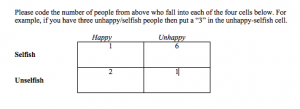Artifact 5:
For module 14, we were asked to answer the Subjective Happiness Scale (SHS). My score ended up being a 5.25, which is an average number according to the scoring chart. While I think that this was an interesting way to measure happiness, I do not believe that it truly captures the results. I think happiness is something that is fluid, and can come and go just like any other emotion. If an individual is feeling happy while they answer the questions, then it seems like his or her score will be pretty high, but if the individual answers these questions on a bad day, then the scores will most likely be low. In that context, the scores could be greatly influenced by how the participant is feeling on that particular day, and therefore does not measure one’s overall happiness.
I believe that happiness is a reaction to one’s environment, as is sadness and fear. In order to maintain happiness, one has to work with the environment he or she is in, and attempt to align it with what the individual believes makes him or her happy. While happiness is not guaranteed, it can be achieved through experiences, and trial and error. Obviously, what constitutes happiness varies from person-to-person. This is largely due to the culture that a person is raised within. Different cultures have different expectations, and achieving or failing those unique expectations can dictate whether or not one is happy.
I included this assignment as my top artifact, because I think that happiness is something that everyone is looking for. Some people are trying to achieve it, while others are maintaining the level of happiness they currently possess. This very notion is part of the reason I decided to go back to school, and try to build a fulfilling life. To portray happiness, I am including the classic and universal image of the yellow smiley face.

https://en.wikipedia.org/wiki/Smiley
Artifact 4:
One of my favorite concepts this semester was in regards to heuristics. In light of this, I wanted to make my fourth artifact about the role that media plays in representative and availability heuristics. Heuristics, which are mental shortcuts that help people make snap decisions, play a huge role in how people think and act. When individuals consume excessive amounts of media (a common theme in today’s society), perceptions are subject to influence. Mass media absolutely has the power to change how individuals perceive others. By exclusively reporting on only the most extreme stories about crime and terrorism, individuals may start to perceive these reported instances as the norm. This can easily influence individuals to view certain countries and regions as nothing more than terrorist territories, despite the fact that terrorists only make up a very small fraction of the countries they reside in. This is especially problematic, because it can lead to stereotyping, intolerance, racism and hatred.
For module 4’s artifact, we were asked to watch a 20-20 report titled Are We Scaring Ourselves to Death, in order to evaluate the media’s influence on society’s perceptions. One of the parts that really stood out to me was early on, when a citizen was being asked if she felt like a gated community would help keep crime out of her neighborhood. Her response was that she wasn’t sure, but “it’s going to make me feel better.” To me, that is one of the major symptoms of this problem, wherein individuals are not concerned so much with the reality of a situation, but are just concerned with how they feel. Rationality can easily be thrown out of the door when people are mislead by exaggerations, and fear becomes the primary emotion.

https://www.youtube.com/watch?v=WmiFShBQDIs
Artifact 3:
For my third top artifact, I chose the module 11 questionnaire, Are People Who Help Happier? Based on the results, I believe the answer to be yes, people who help are happier. More than that though, my results showed that people who are selfish also tend to be unhappy. This particular pairing was my highest based on the 10 people who I probably know best, or have known the longest. The second highest pairing was unselfish people who are happy, which unfortunately was a lower number overall than selfish people who are unhappy. Of course, these results only speak to the people I know quite well, and not the entire world. Still, I think these results tend to apply to most people, wherein unselfish people are probably happier than selfish people. I believe that selfishness and happiness are rarely perceived as going together because selfish people are usually those who are most self-interested, and spend little time enjoying things with others as a result of their own self-interest. A person who will not share his or her apples, because he or she has a fear of going hungry, is not going to be having as much fun as the person who is sharing his or her apples with other people. The person sharing will be engaged with other people, and will most likely experience a rewarding feeling as a result of sharing what he or she has with others. I believe that this is an important lesson that connects with my first artifact, as well as with the “random acts of kindness” assignment. I have included an image of my results matrix to show the full results of my questionnaire.

Artifact 2:
For module 12, we were asked to answer an Aggression Questionnaire. I chose this as my second artifact because aggression is such a challenging thing to pinpoint. The items on the list that I found to indicate aggression the most included a juvenile gang attacking members of another gang, a man viciously kicking a cat, a girl kicking a wastebasket, and a man mentally rehearsing a murder he is about to commit. I chose these items as the most indicative because of the fact that they seem to all be rooted in anger and aggression, and lead to violence and damage. Three of the instances involve harm to living things, while one example includes harm to a nonliving thing. Many of the other items on the list alluded to accidents, self-defense, duty and job responsibility, survival and instincts, and self-injury. I think that these motivations lessen the aggression of some of the actions on the list. For example, the action where two wolves fight for the leadership of the pack features aggression as a tool, but the motivation is based on instinct and survival. Kicking a wastebasket, however seemingly has no motivation other than to cause damage in order to express or satisfy one’s own aggression. I think it is extremely important to evaluate the context of a situation, and explore one’s motivations in order to gauge the level of aggression that an individual may be harboring.
To reflect needless aggression in modern society, I am including an image of a man experiencing road rage. I imagine this individual driving aggressively and exhibiting aggressive behavior’s towards other drivers.

https://driving.ca/mazda/auto-news/news/experiencing-road-rage-heres-what-you-can-do-to-cool-off
Artifact 1:
For module 10’s artifact, we were asked to violate a social norm. The norm I violated occurred on an elevator during a recent shopping trip to MacArthur Mall. Instead of facing the elevator doors, I faced everyone else. I decided that this would be a good place to attempt this particular experiment, because it is a short elevator ride. It was not my aim to make anyone uncomfortable, although I do believe that the other four individuals on the elevator may have felt some discomfort. In going down from the second floor to the first floor, I turned and faced everyone, although my eyes were directed to the back of the elevator, which is glass and offers a view of the mall’s indoor water fountain. I believe I was the third or fourth person to board the elevator, and I was standing roughly in the middle with my back toward the elevator doors. No one said anything, and I was the first person to walk out. It felt pretty awkward, and I mostly just thought about how uncomfortable the other passengers might be feeling while we were riding down. I did not gain any particular insight from this instance, although it did fit with my belief that most people are not interested in any type of perceived conflict. If someone would have interacted with me at all, I might have felt differently. I was not met with any eye contact or given a verbal response. For me, this indicated that people would prefer to allow someone to act strange, as opposed to interacting with them and risking a potentially uncomfortable exchange. This was my least favorite artifact, but I included it because I made it a point to try and violate a social norm.
I was alone for this particular experiment, so I was not able to have a photo taken, but I did find an image online that captured the perspective I had during the interaction.
